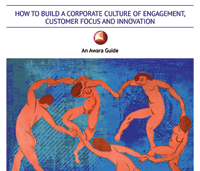Chapter 5: Audit Of Corporate Culture And Engagement
Chapter 5: Audit Of Corporate Culture And Engagement
1,995 views
THIS IS AN INSTALLMENT IN EMPLOYEE ENGAGEMENT IN RUSSIA BY JON HELLEVIG
Organizational consultants love to do surveys, but a survey is not always the right place to start. Especially considering the approach to corporate culture taken in this book, a survey would not necessarily even give the right diagnosis. Surveys, as I have pointed out, aim at finding out how the employee feels about the company, the job, the managers, and himself. Often this yields information in the genre of “nice to know.” But does this all really generate a business value? Why should we assume that the employees can correctly judge the company’s strategy and the challenges it faces, or what is wrong with the business processes? This is especially the case if the organization has not earlier actively propagated and implemented the principles of engagement. The various types of employee surveys that are on offer would rarely, if ever, give answers to the most important question, which is not the degree of job satisfaction of the employee, but the reasons for her low job satisfaction: that is, to show what is wrong with the business processes.
The proper way of developing a corporate culture is to work with all aspects of the company’s entire corporate culture. This is in line with my conviction that a corporate culture is the aggregate reflection of all actions of a company, decisions and behavior of its management and all of its employees, as well as all the business practices and processes. The corporate culture is thus the sum total of all behavior and operating practices (whether formally sanctioned or not) of each individual employee as part of the collective of employees. We also need to remember that the concept of corporate culture should not be restricted, as is done by the typical organizational consultant, to psychological issues such as “the mindset and instincts” of employees and soft issues like corporate traditions and rituals. To remedy the corporate culture, we thus need to look at every element of the business in unison to understand which business practices need to be modified so as to bring about the needed change of culture.
We therefore offer to approach the question from a different point of view, from the point of view of leadership, if you will. This approach is based on a fundamental understanding of what affects corporate culture and engagement, as it has been presented in this book. Then instead of psychological surveys we offer to conduct an audit of how things are organized. Based on the corporate culture audit the leaders may then take action to remedy things. After all, if you focus on data gathering rather than taking action, you could actually damage your engagement efforts. Such a survey without action would actually negatively impact engagement levels. An audit will help to elucidate what hinders the company in enacting a desired corporate culture and engagement and recognizing key areas of action.
Through a corporate culture audit, the company will identify the weaknesses in the corporate culture and help draw up a plan for upgrading it so that the company can reach its full potential on the Russian market. For this, real business management skills are needed so as to identify and change the business processes that affect a company’s culture. We analyze the key aspects of the company’s business in terms of how they are organized and how they function and engage the best specialists in the relevant fields of business. At Awara a corporate culture audit team would consist of management consultants, organizational consultants, lawyers, tax specialists, accountants and IT specialists, as well as human resources specialists. We ask the question: is this company organized for success? And we look for obstacles preventing a business from reaching its full potential. We reveal what stops the company from having a modern and flexible business environment in which innovation can thrive.
Our work on the audit consists of an expert analysis of the key aspects of business by looking at the observable facts. Depending on the case, and the client’s willingness, we may also employ a variety of other methods. These include formal and informal interviews with top management, middle management and specialists; questionnaires and surveys (yes, surveys can be one of the tools employed, but not the sole tool as is often claimed); focus groups; interviews with external sources such as suppliers, customers and former employees; and we may even act as a mystery shopper making test purchases of goods and services.
The culture audit report then describes the present status of the key drivers of the corporate culture and identifies problem areas. This concludes the audit part of the work. After the audit, we engage the company’s executives in a discussion about our findings, and together we brainstorm for solutions. This process is carefully designed to allow leading executives to better understand their business and its place in the market. Details can be found in the chapter Strategic Planning (Appendix 1).
APPENDIX 1 – STRATEGIC BUSINESS PLANNING WITH AWARA
Awara offers a comprehensive service to help business leaders improve, clarify and articulate their business strategy and business plans. After an analysis of the client’s current business situation and future goals, we engage the company’s leaders and the executive team in strategic brainstorming sessions aimed at a crystallization of the best possible strategy. This process is carefully designed to allow the leading executives to better understand their business and its place in the market and the development of a roadmap for achieving these goals.
The strategy and any detailed business plan will have to be preceded by a well-articulated vision and mission. The mission is what the company does or wants to do; vision is what it wants to reach and strategy is how to reach it. In the strategy process we will make sure that the operations in reality are preceded by an articulated vision and mission statement, correspondingly adjusted in the process. Guided by their vision and mission statements, executives will consider what their company will do, where it fits into the current market, and how it will win in the competition. When they have arrived at their strategy, they engage all key employees, including middle management, specialists and all the operative employees in an effort to make the whole organization in reality driven by the strategy. They will foster a culture of strategic thinking.
VISION, MISSION, VALUES/GUIDING PRINCIPLES
Vision – Where we want to go. The vision statement is usually described as a short, succinct, and inspiring statement about the desired future. It outlines where the leaders want the company to be in the future.
Mission – What really is our purpose. The mission statement defines the main purpose and aims of the company concurrent to the vision. It specifies the business, products and services which the company will furnish in pursuit of the vision.
Values – or rather Guiding Principles. Many companies define and publish their so-called core values, which are supposed to represent fundamental philosophical convictions on morality and ethics. But an attempt to individualize these for a particular firm is always doomed to fail as all organizations are anyway supposed to follow the same broad categories of values. Therefore it will be more meaningful, and honest, to speak about guiding principles instead of values. That way we also avoid the kinds of slogans, platitudes and tag lines which most firms proclaim as their values. Guiding principles are down-to-earth principles regarding organizational structure, intended corporate culture, approach to bureaucracy, and other related things. They are principles that guide an organization throughout its life in all circumstances, irrespective of changes in its goals, strategies, type of work, or the top management.
The brainstorming and planning process makes use of a wide variety of alternative or complimentary methods for identifying the internal and external factors and parameters that affect the vision and strategy. Such methods are, for example, a SWOT analysis, to identify Strengths, Weaknesses, Opportunities and Threats; the PEST method, or something similar, to identify Political, Economic, Social, Technological, Cultural, Ecological, and Normative factors that affect the business environment; Scenario planning, etc.
The market and rivals are analyzed in terms of Michael Porter’s five competitive forces framework for industry analysis and business strategy development
1. Existing competitors (Competitors)
2. Entry of new competitors (Competitors)
3. Threat of substitutes (Product, Service)
4. Buyers’ bargaining power (Clients)
5. Suppliers’ bargaining power (Suppliers)
Through these steps we will grasp and define the objectives of the organization in terms of their importance, priorities, feasibility and time frame within which they can be reached. After this, short-term and long-term goals (milestones) can be charted.
PORTER’S FIVE COMPETITIVE FORCES
Existing competitors:
- Industry growth
- Fixed (or storage) costs/value added
- Intermittent capacity
- Product differences
- Brand identity
- Switching costs
- Concentration and balance
- Informational complexity
- Diversity of competitors
- Corporate stakes
- Exit barriers
Substitutes:
- Relative price performance of substitutes
- Switching costs
- Buyer propensity to substitute
Suppliers’ bargaining power:
- Differentiation of inputs
- Switching costs
- Presence of substitute inputs
- Supplier concentration
- Importance of volumes
- Cost relative to total purchases in the industry
- Impact of inputs on cost and differentiation
- Threat of forward integration relative to threat of backward integration by firms in the industry
Entry barriers:
- Economics of Scale
- Proprietary product differences
- Brand identity
- Switching costs
- Capital requirements
- Access to distribution
- Absolute cost advantages
- Proprietary learning curve
- Access to necessary inputs
- Proprietary low-cost product design
- Government Policy
- Expected retaliation
Buyers’ bargaining power:
Bargaining leverage
- Buyer concentration vs. firm concentration
- Buyer volumes
- Buyer switching costs relative to firm switching costs
- Buyer information
- Ability to backward integrate
- Substitute products
- Pull-through
Price sensitivity:
- Price/total purchases
- Product differences
- Brand Identity
- Impact on quality/performance
- Buyer profits
- Decision maker incentives
STRATEGIC CORE
In the strategic planning we really try to reach the strategic core, or what Jim Collins has identified as the three main elements of strategic thinking2. These are the key dimensions of strategic thinking which should simultaneously serve as a frame of reference for all the main business decisions:
1. What the company can be really good at.
2. What the economic drivers of the business are.
3. What you are deeply passionate about.
Each firm should determine for itself what it has the potential of being the best at and then go for that. This is not even necessarily the same as the company’s present core competence. Just because a firm has a core competence, does not mean that it is what it can be the best in it. To achieve excellence, you might even have to drop the field of your present core competence and develop a new one. With understanding what you can be the best at comes also an understanding of what you cannot do better than any other company.
The economic drivers are the parameters which measure the events that have the greatest impact on the business success. Such economic drivers are, for example: “profit per customer,” “profit per store,” “profit per customer visit,” “profit per employee,” “profit per brand,” and “profit per ton of steel.”
When we refer to what you are passionate about, we mean the shared passion of the company and its key constituents. This is not a question of stimulating passion, but of discovering what you are passionate about. Ultimately the leaders have to be able to ignite the same passion throughout the organization.
ACTIVITY BASED
In the process of strategic planning we adapt Michael Porter’s activity based method of analysis building on his insight that a firm is a collection of activities3. In keeping with this view we aim at identifying the distinct set of activities that make up its value chain. We need to analyze the structure of activities and their costs. In this way strategy does not amount to a broad vision, but rather the particular configuration of activities a firm adopts relative to the competition and its market. The strategy will then consist of targets and actions that should easily translate into an action plan that can generate a roadmap. They can be either specific or general, and should always be concrete, realistic (achievable) and time-limited. The activities shall be grouped as components of the value chain consisting both of operational (primary) and support activities. It is useful to analyze the activities in terms of the product life cycle (from inception to delivery). The activities may be grouped into, for example, the following categories:
|
|
It is a question of determining the competitive advantages in terms of all the activities and the optimal way of producing them from the point of view of cost, quality, management structure, organizational design and feasibility. The firm has to determine what competitive advantages it is seeking, how to differentiate its products and services, and which customer (product) segments to focus on. Where does the firm’s uniqueness lie: in sales, marketing, technology, design, or something else? What are the real expectations of customers in general and in particular?
A CULTURE OF STRATEGIC THINKING
It is no good having a strategy if the people that you rely on to implement it don’t know the strategy and the goals you are pursuing. You have to align your people with the strategy and communicate to the organization what people on respective levels need to know about the strategy. All individuals have to be made aware of the new strategy in terms they can understand. They need to feel the commitment to the strategy as their own. This is why you need to engage your whole organization to put the strategy into practice. By applying the principles of engagement the leadership has to put in place a culture of strategic thinking. This is an environment where people know the strategy, its background, the future goals you pursue and your guiding principles, and where they are encouraged to actively contribute to the strategy by thinking and expressing their thoughts in terms of the strategy. At each level people need to have the means of translating the strategic goals and objectives into day-to-day projects and tasks.
A firm is a collection of activities, the results of which is based on the behavior of its staff
1. Porter Michael, Competitive Advantage, 2004. Free Press
2. Collins, Jim. From Good to Great. 2001
3. Porter, Michael. Competitive Advantage, 2004
Would you like to share your thoughts?
Your email address will not be published. Required fields are marked *



0 Comments